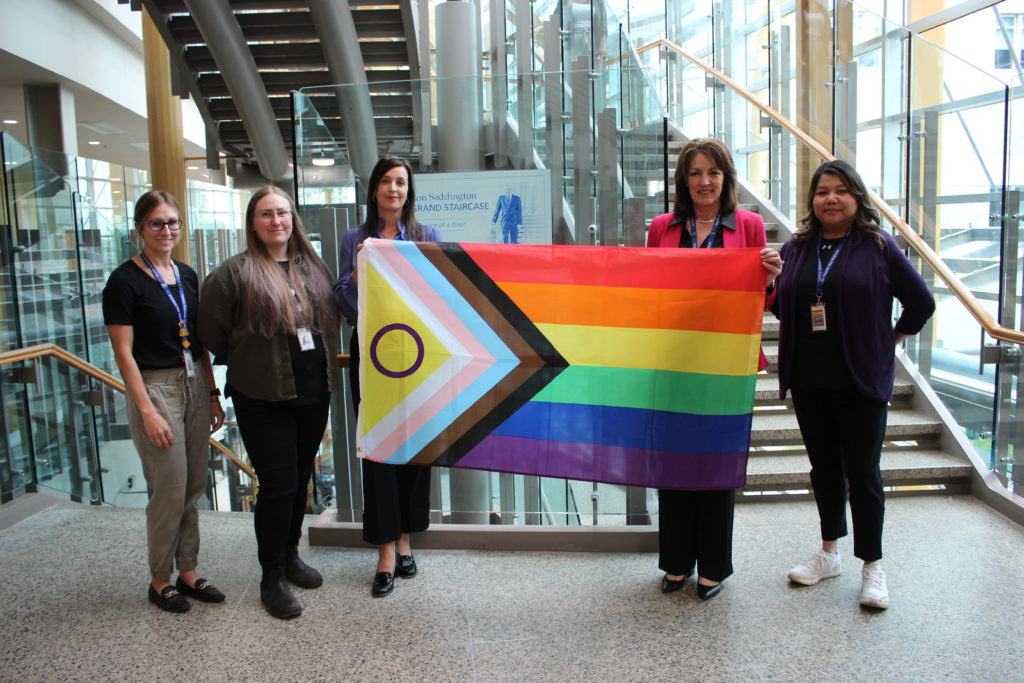
Happy Pride Month! Thunder Bay Regional Health Sciences Centre (TBRHSC) is proud to fly the Intersex-Inclusive Progress Pride flag and celebrate the diversity and resilience of the 2SLGBTQQIA+ community throughout the month of June. We recognize the ongoing inequities faced by gender and sexually diverse individuals, particularly within the health care system. TBRHSC’s Pride Working Group, representing the Equity, Diversity, and Inclusion (EDI) Steering Committee, will host events throughout the month to encourage everyone to celebrate Pride and foster a more inclusive future for 2SLGBTQQIA+ patients, families, staff, and community members.
TBRHSC is committed to integrating equity, diversity, and inclusion into our patient care, as emphasized in our Strategic Plan 2026. Please join us in celebrating diversity and togetherness this Pride Month!
What does the 2SLGBTQQIA+ acronym stand for?
Two-Spirit, Lesbian, Gay, Bisexual, Transgender, Queer, Questioning, Intersex, Asexual, as well as other A identities, such as Aromantic, and Agender. The plus sign represents all other gender and sexually-diverse individuals who may describe their identity using other terminology. Below are definitions for each identity represented in the 2SLGBTQQIA+ acronym.
| 2S | Two-Spirit | A culturally specific identity describing Indigenous individuals whose gender, spiritual, or sexual identity includes both male and female spirits. The term honors gender and sexual diversity and emphasizes the ability of Two-Spirits to navigate both worlds and hold male and female responsibilities in their communities. While the concept of Two-Spirit individuals has existed among Indigenous Peoples for generations, the term niizh manidoowag, meaning “two spirits,” was first proposed in 1990 by Elder Myra Laramee. |
| L | Lesbian | Refers to women or non-binary individuals who are attracted to people of the same or similar genders |
| G | Gay | A person who is sexually and/or romantically attracted to people of the same sex or gender identity |
| B | Bisexual | A person who experiences attraction to individuals who share their gender identity, as well as individuals whose gender is different from their own |
| T | Transgender (Trans) | The term Transgender refers to individuals who cross or transcend the culturally defined boundaries of gender. Individuals who identify as Trans often feel that their gender identity differs from their sex assigned at birth. This occurs to differing degrees for each Trans person |
| Q | Queer | An umbrella term used to describe one’s identity in the 2SLGBTQQIA+ community, including more complex experiences of gender identity and expression, sexuality, and attraction |
| Q | Questioning | The process of learning about one’s gender identity and sexual orientation. This process may occur over a single period, episodically, or throughout one’s lifetime |
| I | Intersex | Individuals for whom chromosomes, hormones, or anatomical sex characteristics fall outside of the conventional classifications of male or female |
| A | Asexual, Aromantic, Agender | Asexual: A person who experiences no sexual attraction and/or interest in sexual activity. Asexual can also be used as an umbrella term to describe those with varying degrees of sexual attraction and desire, including demisexual and graysexual Aromantic: A person who experiences little to no romantic attraction to others Agender: A person whose gender identity is experienced as being neutral, or having no gender |
| + | Other sexual and gender identities | Inclusive of people who identify as part of sexual and gender diverse communities, who use additional terminologies |
To learn more about the history of Two Spirit folks, please go to: https://www.theindigenousfoundation.org/articles/the-history-of-two-spirit-folks
To learn more about 2SLGBTQQIA+ identities, please go to Egale Canada at: https://egale.ca/awareness/terms-and-definitions/
History of Pride in Canada
On May 14, 1969, Canada decriminalized homosexuality, following the introduction of Bill C-150 by then Prime Minister Pierre Elliott Trudeau. The bill received royal assent the day before the Stonewall Uprising began in New York City, on June 27, 1969.
The Stonewall Uprising was a significant turning point for 2SLGBTQQIA+ rights in the US, but Canada has its own unique Pride history. The first gay liberation march, known as the “We Demand” March, was held on Parliament Hill on August 28, 1971, the second anniversary of the enactment of Bill C-150. This was followed in 1973 by Canada’s first Pride events, which were held in several Canadian cities.
Over the proceeding decades, Canada continued to make strides toward 2SLGBTQQIA+ rights. From amendments to the Canadian Human Rights Act, and the Canadian Charter of Rights and Freedoms the Canadian to include protections for sexual orientation and gender identity and expression, to becoming the fourth country in the world to legalize same-sex marriage.
Despite this progress, 2SLGBTQQIA+ individuals continue to face inequities and discrimination that impacts their health and wellbeing, which is why it remains critical to continue to advocate for change.
To learn more about the history of Pride in Canada, click here to see a timeline, or go to: http://www.queerevents.ca/queer-history/canadian-history-timeline
What do the colours of the Pride flag represent?
The Pride flag is one of the most recognized symbols of the 2SLGBTQQIA+ community. First created by Gilbert Baker in 1978, the original Pride flag featured eight colours: hot pink, red, orange, yellow, green, turquoise, blue, and purple.
Since its inception, the Pride flag has undergone many changes. This includes the removal of the pink and turquoise stripes, followed by the addition of black and brown stripes to represent communities of colour, with black also representing the lives lost during the HIV/AIDS crisis. Light blue, pink, and white were subsequently added to represent the Trans community; and a purple circle on a yellow background represents the Intersex community.
The current Pride flag is the Intersex-Inclusive Progress Pride flag, which was developed in 2021 by Valentino Vecchietti. The six rainbow colours represent:

- Red: Life
- Orange: Healing
- Yellow: Sunlight
- Green: Nature
- Blue: Serenity
- Purple: Spirit
To learn more about the history of the Pride flag, please go to the Human Rights Campaign at: https://www.hrc.org/resources/lgbtq-pride-flags
